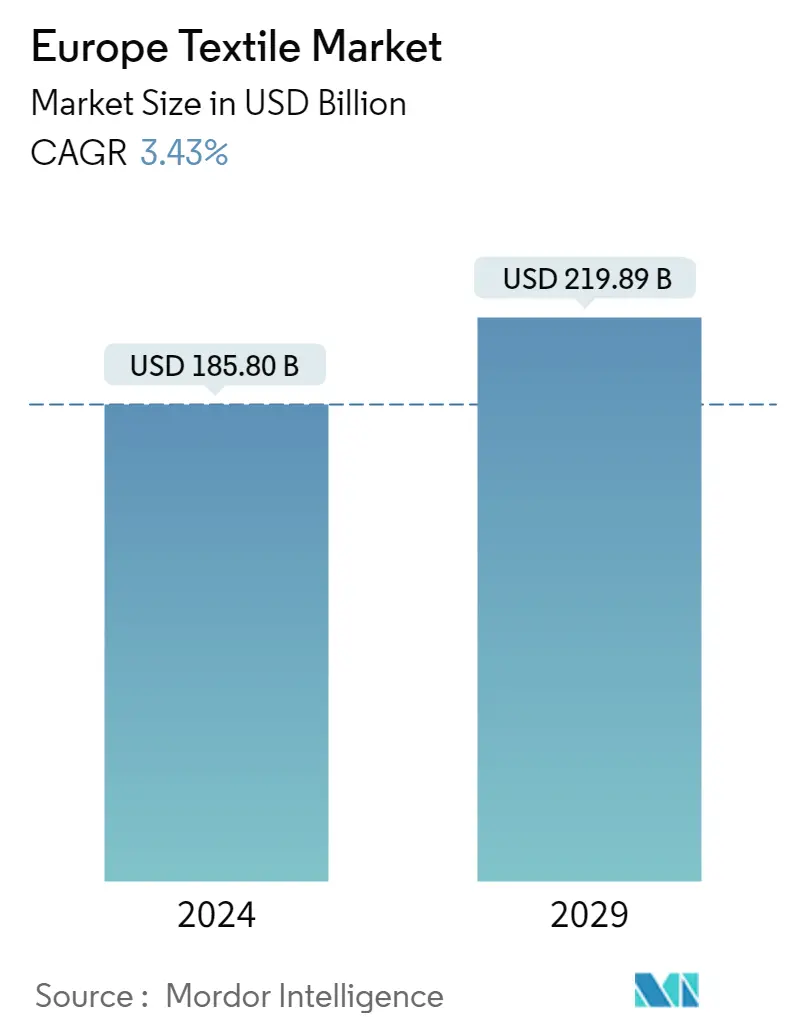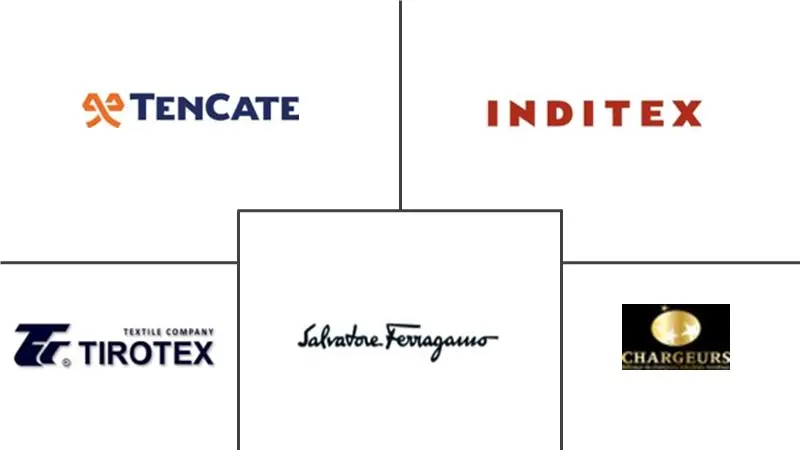Market Size of Europe Textile Industry

| Study Period | 2020 - 2029 |
| Base Year For Estimation | 2023 |
| Market Size (2024) | USD 185.80 Billion |
| Market Size (2029) | USD 219.89 Billion |
| CAGR (2024 - 2029) | 3.43 % |
| Market Concentration | Medium |
Major Players
*Disclaimer: Major Players sorted in no particular order |
Europe Textile Market Analysis
The Europe Textile Market size is estimated at USD 185.80 billion in 2024, and is expected to reach USD 219.89 billion by 2029, growing at a CAGR of 3.43% during the forecast period (2024-2029).
In Europe, the textile industry significantly contributes to the economy, employing nearly 6% of the working class in total manufacturing. After COVID-19, there was an inclination toward the latest fashion trends among the young generation. Changing collections every three weeks has induced consumers to act with new behavior.
Digital platforms and digital marketing strategies are becoming prevalent in the European fashion market, and many new brands have emerged with the development of e-commerce, which allows companies to engage consumers through virtual reality. The fashion and online apparel industry is the one that marks the most significant growth in e-commerce sales. Therefore, the advent of online platforms has increased consumer spending on clothing through these channels, driving sales and revenue in the European textile market.
Europe Textile Industry Segmentation
The textile industry is the platform or industry in which the development, production, processing, manufacture, and distribution of textile and fabric materials occur. The textile market industry is concerned with the design, production, and distribution of yarn, cloth, clothing, and garments. The raw material may be natural or synthetic, which may be using products of the chemical industry. The European textile market is segmented by application type (clothing, industrial/technical applications, and household applications), material type (cotton, jute, silk, synthetics, and wool), and process type (woven and non-woven). The report offers Market Size and forecasts for the Europe Textile Market in value (USD) for all the above segments.
| Application | |
| Clothing | |
| Industrial/Technical Applications | |
| Household Applications |
| Material Type | |
| Cotton | |
| Jute | |
| Silk | |
| Synthetics | |
| Wool |
| Process | |
| Woven | |
| Non-woven |
Europe Textile Market Size Summary
The European textile industry plays a crucial role in the continent's economy, employing a significant portion of the manufacturing workforce. The sector is experiencing a transformation driven by digitalization and changing consumer behaviors, particularly among younger demographics who are increasingly drawn to the latest fashion trends. The rise of e-commerce and digital marketing has facilitated the emergence of new brands and enhanced consumer engagement through innovative platforms. This shift has led to a notable increase in online apparel sales, contributing to the overall growth of the European textile market. Additionally, there is a growing demand for organic and sustainable textiles, as consumers become more environmentally conscious. The industry is responding by investing in research and development to create eco-friendly products, with major brands incorporating organic and recycled materials into their offerings.
The market is further bolstered by rising disposable incomes and a preference for online shopping, which varies across different regions. European consumers allocate a significant portion of their expenditure to clothing, with a notable demand for premium and branded products. The region is home to numerous leading retailers, designers, and innovative entrepreneurs, contributing to the high demand for European textiles and fashion products both domestically and internationally. Technical textiles have also seen success, with continuous growth in trade. Key players in the industry, such as Salvatore Ferragamo SpA, Koninklijke Ten Cate NV, and Inditex, are instrumental in driving market expansion. Recent acquisitions, like Lectra's purchase of TextileGenesis‚Ñ¢ and Archroma's acquisition of Huntsman's Textile Effects business, highlight the industry's focus on sustainability and innovation.
Europe Textile Market Size - Table of Contents
-
1. MARKET INSIGHTS AND DYNAMICS
-
1.1 Market Overview
-
1.2 Market Drivers
-
1.2.1 Growing Awareness of the Latest Fashion Trends Among the Young Generation
-
-
1.3 Market Restraints
-
1.3.1 High Wastage
-
1.3.2 Market Opportunities
-
1.3.2.1 Increasing Trend of Smart Textiles
-
-
-
1.4 Value Chain / Supply Chain Analysis
-
1.5 Porter's Five Forces Analysis
-
1.5.1 Bargaining Power of Suppliers
-
1.5.2 Bargaining Power of Buyers/Consumers
-
1.5.3 Threat of New Entrants
-
1.5.4 Threat of Substitute Products
-
1.5.5 Intensity of Competitive Rivalry
-
-
1.6 Impact of COVID-19 on the Market
-
1.7 Insights on Latest Technologies Used in the Industry
-
-
2. MARKET SEGMENTATION
-
2.1 Application
-
2.1.1 Clothing
-
2.1.2 Industrial/Technical Applications
-
2.1.3 Household Applications
-
-
2.2 Material Type
-
2.2.1 Cotton
-
2.2.2 Jute
-
2.2.3 Silk
-
2.2.4 Synthetics
-
2.2.5 Wool
-
-
2.3 Process
-
2.3.1 Woven
-
2.3.2 Non-woven
-
-
Europe Textile Market Size FAQs
How big is the Europe Textile Market?
The Europe Textile Market size is expected to reach USD 185.80 billion in 2024 and grow at a CAGR of 3.43% to reach USD 219.89 billion by 2029.
What is the current Europe Textile Market size?
In 2024, the Europe Textile Market size is expected to reach USD 185.80 billion.

